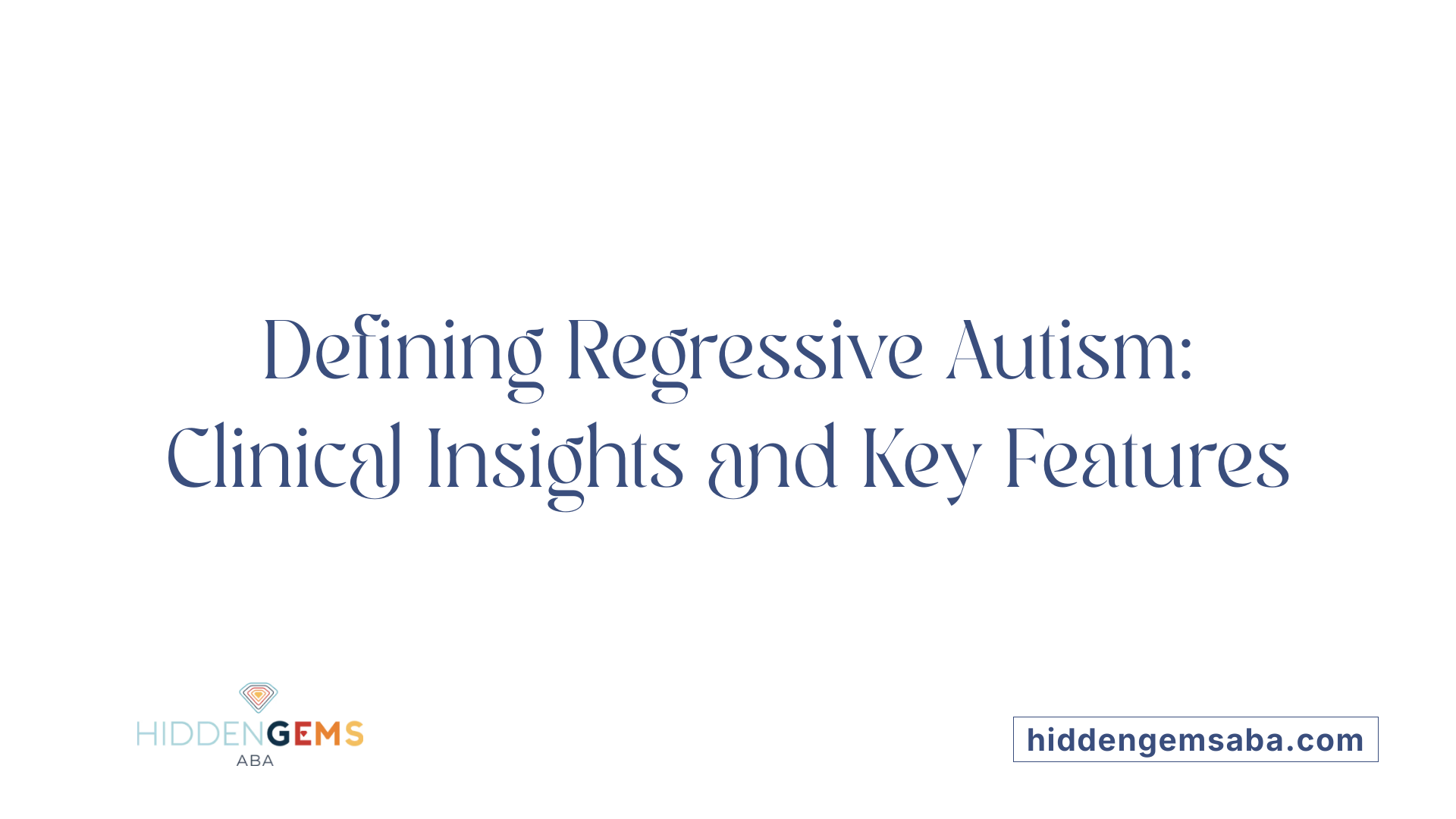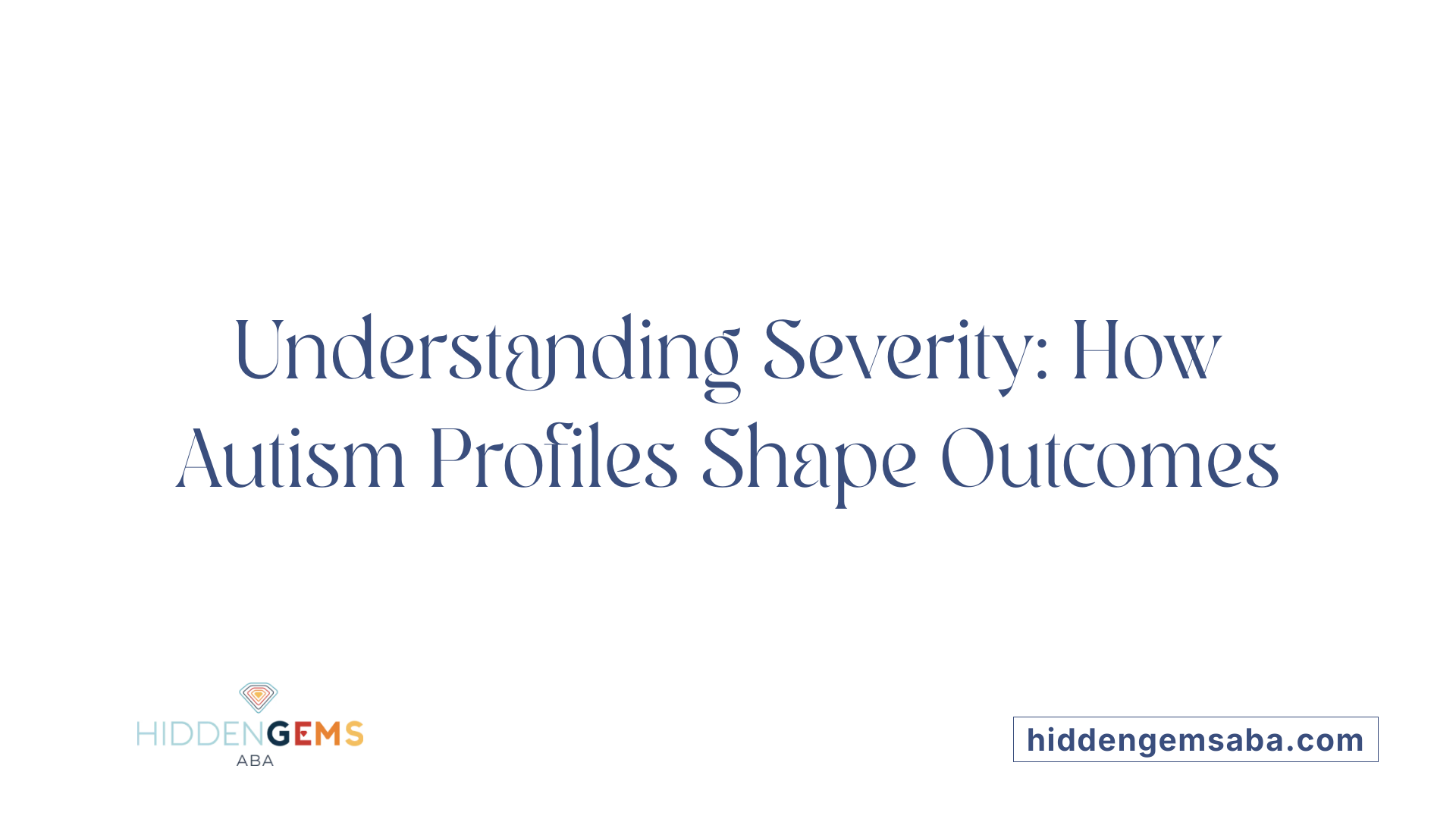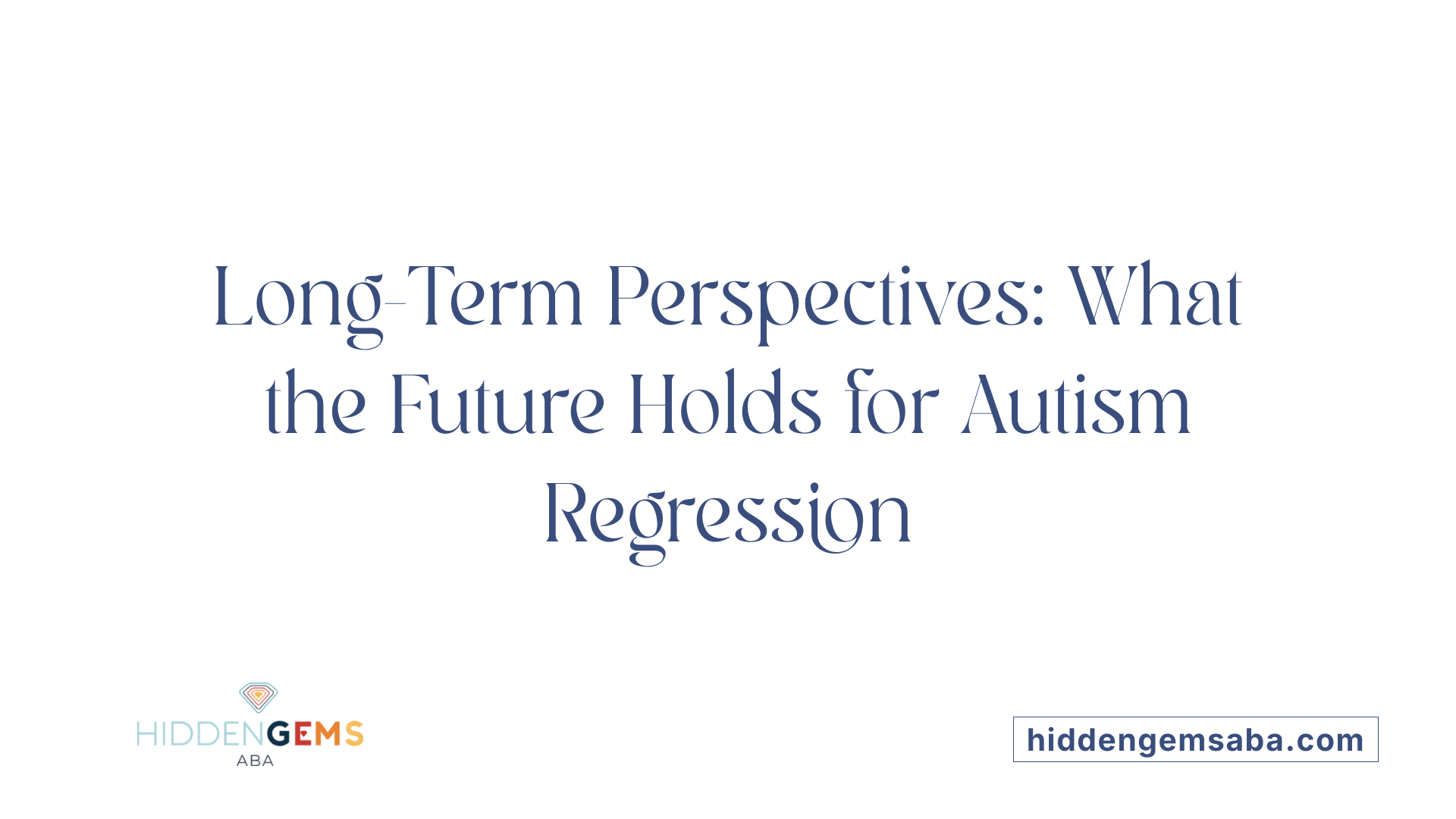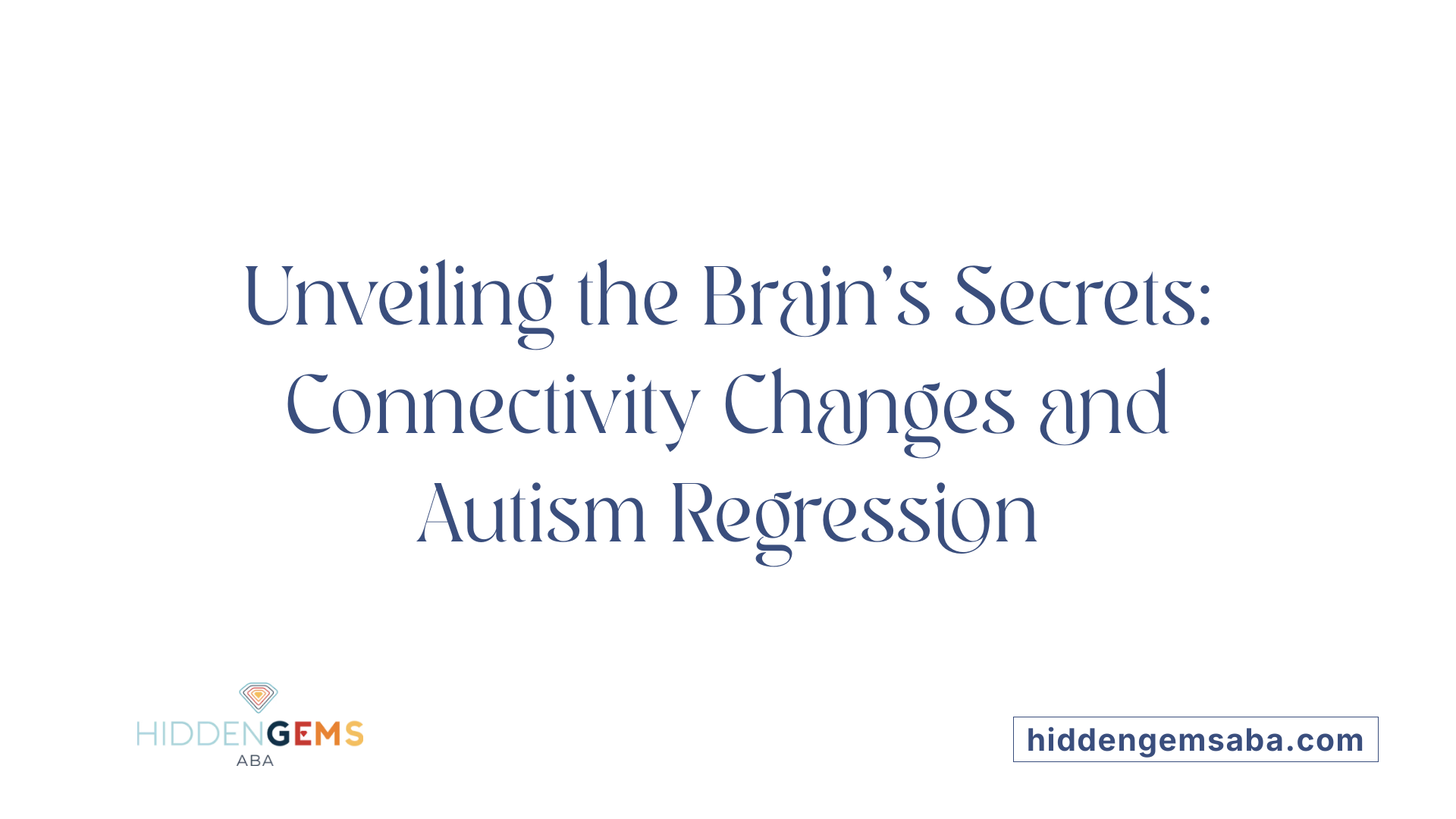Unraveling the Complexities of Regressive Autism and Pathways Toward Recovery
Regressive autism, a challenging and often misunderstood form of autism spectrum disorder (ASD), involves the unexpected loss of previously acquired developmental skills, such as speech, social engagement, and motor abilities, typically occurring between 15 and 30 months of age. Recent research underscores the importance of early detection and intervention, which can significantly influence developmental outcomes. This article delves into the characteristics, causes, early signs, and treatment options of regressive autism, emphasizing the potential for recovery and ongoing scientific advancements.
Understanding Regressive Autism: Definitions and Clinical Profile

What is regressive autism, and how does it differ from other forms of autism?
Regressive autism is a subtype of autism spectrum disorder (ASD) where a child develops typically or near-typically, then unexpectedly loses developmental skills, especially language and social abilities, often between 15 to 30 months of age. This loss can be heartbreaking for families as children suddenly stop speaking, withdraw socially, or lose previously acquired gestures and communication skills.
In contrast to early-onset autism, where symptoms are usually present from very early infancy, children with regressive autism seem to develop normally at first before facing a decline. This difference in developmental trajectory makes regressive autism distinct. Children with the regression tend to experience more severe symptoms and face greater difficulties in adaptive functioning, such as daily living skills.
The underlying causes of regression involve complex biological factors, including genetics, brain development, and possibly environmental influences. Research suggests that regression may correspond with changes in brain connectivity, such as overaggressive pruning of neural connections during critical periods of development.
Early identification through vigilant developmental monitoring is crucial. Recognizing signs of regression can lead to earlier intervention, which can significantly improve language and social skills—especially when started before the age of four. Overall, understanding the differences between regressive and early-onset autism helps in tailoring intervention strategies to support affected children effectively.
Early Signs and Detection of Regression
What are the early signs and contributing factors of regression in autism spectrum disorder?
Regression in autism spectrum disorder (ASD) usually occurs between the ages of 15 and 30 months. Parents and caregivers might notice that a child who previously used words or made eye contact suddenly loses these skills. Social engagement, such as smiling or playing normally, may decline as well.
Before regression becomes evident, some children exhibit subtle differences or delays. These may include mild delays in babbling, reduced social responses, or less interest in interactive play. These early signs can be easily overlooked but are important indicators that warrant attention.
The causes of regression are complex and not yet fully understood. It is believed to involve a mix of genetic, neurological, immune, and environmental factors. Brain changes, such as altered connectivity and possibly overaggressive pruning of neural connections during early development, are associated with this process.
External factors like immune system irregularities, inflammation, and environmental stresses—such as illness or significant changes in routine—may trigger or exacerbate regression.
Signs preceding regression
Signs that may indicate an impending regression include:
- Slight decrease in social interactions
- Mild setbacks in language development
- Reduced eye contact or social smiling
- Increased irritability or withdrawal
Monitoring these subtle changes is crucial for early detection.
Tools for early detection
Early detection relies on careful observation of developmental progress through history and assessment. Techniques such as eye tracking and brain imaging are promising tools in identifying children at risk before overt symptoms appear.
Screening and developmental checklists, coupled with parent reports, help clinicians spot early signs. For children at high risk, especially infant siblings of children with autism, ongoing tracking of developmental milestones can catch regression early.
Early intervention, including speech, occupational, and behavioral therapies, can then be implemented to support skill retention and development. Recognizing regression early improves the chances of mitigating its impact and enhances long-term outcomes.
Prevalence and Significance of Regression in Autism
What is the incidence of regression in autism?
Recent studies reveal that about 28.38% of children diagnosed with autism experience regression. This significant proportion underscores that regression is a common aspect within the autism spectrum.
How does this compare to previous beliefs?
Historically, regression was thought to be a rare phenomenon in autism. However, emerging evidence suggests that it might be more prevalent than previously believed, affecting roughly one in four children with ASD. This shift in understanding emphasizes the importance of closely monitoring developmental progress over time.
What do studies on high-risk populations show?
Research involving infant siblings of children with autism indicates that signs of regression can begin as early as 6 months to 1 year of age. Tracking development in high-risk groups underscores the importance of early detection, as regression often involves the loss of social communication and language skills.
Why does regression matter for diagnosis?
Regression is primarily manifested in the deterioration of social engagement and language abilities. Children with regressive ASD tend to have more severe symptoms and lower neurodevelopmental levels, which are reflected in higher scores on assessment scales like the Social Response Scale (SRS) and Children Autism Rating Scale (CARS).
Biological and environmental factors involved
The causes of regression are complex and involve interactions between genetic factors and environment. Brain changes such as altered connectivity and overpruning of neural circuits during early development may underpin regression. Environmental influences, including inflammation, may also play a role.
Implications for early intervention
Recognizing regression early is crucial, as interventions before age 4—particularly in non-regressive cases—have shown to significantly improve language and social skills. Technologies like eye tracking and brain imaging could assist in identifying children at risk before overt symptoms appear, potentially reducing developmental losses.
| Aspect | Details | Additional Notes |
|---|---|---|
| Incidence rate | Approximately 28.38% of children with ASD | Indicates regression is common |
| Age of onset | Typically between 18-30 months, early signs may appear from 6 months | Early signs detectable through neurobiological markers |
| Affected skills | Social communication and language | Significant impact on developmental trajectory |
| Biological factors | Brain overpruning, connectivity changes | Underlying neurobiological mechanisms under investigation |
| Environmental influences | Inflammation, prenatal factors | Affect the onset and severity |
| Early interventions | Before age 4, targeted behavioral therapies | Associated with better outcomes |
Understanding that regression is a common and impactful feature of autism highlights the need for ongoing research into its biological underpinnings and early identification methods. Enhanced awareness and early detection can lead to timely intervention, potentially mitigating long-term developmental consequences.
Impact of Severity and Neurodevelopmental Profiles

How severe are the core symptoms in children with regressive ASD compared to non-regressive ASD?
Children with regressive ASD tend to exhibit more intense core symptoms of autism. These symptoms include significant challenges in social communication, repetitive behaviors, and limited self-care skills. The severity is often reflected in higher scores on standardized scales such as the Autism Rating Scale (CARS) and the Social Response Scale (SRS). Children experiencing regression generally show more pronounced difficulties across these domains, indicating a more severe presentation of autism.
What differences are observed between children with regressive and non-regressive ASD?
Children with regressive ASD typically present with a notable loss of skills they previously acquired, especially in language and social interactions. This regression often becomes evident around 15 to 30 months of age. In contrast, children with non-regressive ASD do not experience such skill loss; instead, their developmental delays are apparent from early on without regression.
How do neurodevelopmental levels compare in regressive versus non-regressive children?
Research shows that children with regressive ASD tend to have lower overall neurodevelopmental functioning. They exhibit greater delays in language, cognitive skills, and adaptive behaviors. The regression phase correlates with changes in brain connectivity and growth patterns, possibly linked to abnormal pruning of neural connections during critical periods of development. Consequently, these children often face more significant challenges in acquiring new skills even after intervention.
| Aspect | Regressive ASD Children | Non-Regressive ASD Children | Additional Details |
|---|---|---|---|
| Symptom Severity | Higher, more severe | Milder, more stable | Assessed by CARS and SRS scores |
| Behavioral Manifestations | Loss of language, social skills, motor skills | Persistent developmental delays | Regression mainly in social communication and language |
| Neurodevelopmental Level | Lower overall cognitive and adaptive abilities | Slightly better neurodevelopmental levels | Reflects more severe developmental impact |
| Age When Regression Occurs | Usually between 6 months and 1 year | No regression reported | Early signs may be subtle and require careful tracking |
| Impact on Long-term Outcomes | Generally more challenging to improve | Better prognosis with early intervention | Emphasizes importance of early diagnosis |
Why is early intervention especially important?
Children with regressive autism benefit from early behavioral therapies, especially if started before age 4. These interventions are particularly effective in improving language and social skills in children who show signs of regression. Early diagnosis and targeted support can help mitigate some of the severity related to neurodevelopmental delays, ultimately enhancing long-term outcomes.
Understanding the distinctions in severity and neurodevelopmental profiles between regressive and non-regressive ASD is crucial. It guides tailored interventions and emphasizes the importance of close developmental monitoring from infancy.
Treatment Modalities and Interventions
What are the treatment options and interventions available for children with regressive autism?
Managing regressive autism involves a comprehensive approach tailored to each child's unique needs. Early intervention is especially crucial, with behavioral therapies being the cornerstone. These include behavioral interventions such as Applied Behavior Analysis (ABA), speech therapy, and occupational therapy, which aim to improve communication, social engagement, and daily life skills.
Beyond behavioral approaches, biomedical treatments are also utilized to address underlying physiological issues. These therapies often target mitochondrial dysfunction, folate pathway abnormalities, redox imbalances, and tetrahydrobiopterin (BH4) metabolism. Common biomedical interventions include the use of antioxidants, methylcobalamin (a form of vitamin B12), folinic acid, and tetrahydrobiopterin supplements. Many children show improvements in core symptoms and associated behaviors following such treatments.
Immune-based therapies represent another avenue, especially when immune dysregulation or evidence of immune involvement accompanies regression. Corticosteroids can reduce inflammation, while flavonoids like quercetin and intravenous immunoglobulin (IVIG) are used to modulate immune responses. Some studies have reported positive effects on behavior and social skills with these treatments.
Diet and gastrointestinal management are also critical components. Gastrointestinal problems are common among children with autism, and dietary modifications such as elimination diets, probiotics, and addressing food allergies can improve both physical health and behavioral symptoms.
In summary, treatment modalities for regressive autism are diverse and often combined. This personalized approach fosters the best potential outcomes in development and overall quality of life.
| Treatment Type | Examples | Purpose | Additional Notes |
|---|---|---|---|
| Behavioral therapies | ABA, speech, occupational therapy | Improve communication, social skills, daily functioning | Most effective when started early, ideally before age 4 |
| Biomedical treatments | Antioxidants, methylcobalamin, folinic acid, tetrahydrobiopterin | Target physiological abnormalities | Often used alongside behavioral therapies |
| Immune-based therapies | Corticosteroids, IVIG, flavonoids | Modulate immune response, reduce inflammation | Used in specific cases with immune dysregulation |
| Diet and GI management | Elimination diets, probiotics, allergy testing | Address gastrointestinal issues, improve behavior | Can contribute to overall health and cognitive function |
Childhood regression in autism, especially when identified early, can be mitigated through a multidisciplinary, individualized treatment plan. Advances in understanding the biological and environmental factors involved continue to refine these approaches, offering hope for better developmental outcomes.
Potential for Recovery and Factors Influencing Outcomes

Are there stories or research findings about recovery from regressive autism?
Research and clinical reports indicate that some children diagnosed with regressive autism can experience meaningful improvements, especially with early and targeted intervention. Case studies highlight children who, after intensive therapies and sometimes dietary modifications, demonstrate significant gains in social engagement, language skills, and behavioral regulation.
For instance, some children undergo dietary changes such as gluten- and dairy-free diets aimed at improving gut health, which some families report as contributing to breakthroughs in symptoms. Complementary therapies like speech therapy, occupational therapy, and behavioral interventions also play essential roles in fostering progress.
While these improvements can be impressive, they often do not mean complete recovery. Long-term follow-up studies suggest residual challenges—including attention deficits, language delays, and behavioral issues—may persist despite overall progress.
This variability underscores that outcomes differ widely among children with regressive autism. Some may see significant enhancements, whereas others may require ongoing symptomatic support. Still, early diagnosis paired with comprehensive intervention remains the most promising approach to maximizing developmental potential.
In summary, recovery stories emphasize hope but also highlight the importance of sustained intervention and realistic expectations, acknowledging that each child's journey is unique.
Prognosis and Long-term Outlook

What is the likelihood of recovery or improvement in children with regressive autism, and what factors influence prognosis?
Children diagnosed with regressive autism exhibit a wide spectrum of developmental outcomes. Research indicates that while full recovery of lost skills is uncommon, with roughly only 1% achieving complete regression reversal, many children show varying degrees of progress over time.
Early intervention plays a crucial role. Children who receive behavioral and developmental therapies, especially around the age when regression occurs—often between 19 to 25 months—tend to have better long-term outcomes. Initiating therapy promptly after the onset of regression is associated with notable improvements in language, social skills, and adaptive functioning.
Several factors impact the prognosis for children with regressive autism. These include the severity of initial developmental delays and regression, the presence of additional medical conditions such as autoimmune encephalitis (AE) or Down syndrome regression disorder (DSRD), and the child's unique neurobiological makeup.
Importantly, in cases where regression is linked to underlying neurological or immune-based conditions, targeted treatments like immunotherapy can result in meaningful improvements. This highlights the importance of comprehensive medical assessments for children showing regression.
Overall, the outlook depends on early detection and a multidisciplinary approach to intervention. Addressing medical, neurological, and developmental aspects increases the chances of optimal progress.
Factors affecting prognosis
| Factor | Impact | Additional Details |
|---|---|---|
| Timing of intervention | Early intervention correlates with better outcomes | Ideal to start therapies soon after regression onset |
| Severity of initial delays | More severe delays often predict more challenges | Severity measured through developmental scales and assessments |
| Presence of comorbid conditions | Can complicate treatment and outcomes | Includes neurological, autoimmune, or genetic conditions |
| Biological and neurodevelopmental profile | Influences responsiveness to interventions | Patterns of brain connectivity and growth are indicators |
| Underlying medical factors | Conditions like autoimmune issues may respond to targeted therapy | Such treatments can lead to improvement in symptoms |
Role of early intervention
Emerging evidence supports that early diagnosis—potentially before overt behavioral symptoms emerge—can significantly improve long-term developmental trajectories. Technologies such as eye tracking and brain imaging are promising tools for early risk detection.
By understanding the brain mechanisms involved in regression, such as overaggressive pruning of neural connections, researchers are aiming to develop intervention strategies that can support brain development before extensive skill loss occurs.
Preventive approaches could include monitoring high-risk infants—such as siblings of children with autism—and applying supportive measures early. Environmental factors like inflammation are also being investigated to understand their role in regression, opening pathways for preventative therapies.
In sum, early identification and intervention are vital. They hold the potential not only to reduce the severity of developmental losses but also to improve overall outcomes and quality of life for children with regressive autism.
Emerging Research and Future Directions
What are the current research efforts to better understand and treat regressive autism?
Recent studies emphasize the importance of understanding the biological processes underlying autism regression. Scientists are exploring brain mechanisms such as altered connectivity and the overpruning of neural connections, which may contribute to the loss of communication and social skills characteristic of regression.
Advanced neuroimaging tools, including magnetic resonance imaging (MRI), are being used to detect early signs of these brain changes. Eye-tracking technology also offers promising avenues for identifying subtle behavioral and neurological markers that precede outward regressive symptoms.
Understanding immune system involvement has gained traction as well. Researchers are investigating immune responses and inflammation, which may influence or trigger regression in susceptible children.
Gene-environment interactions are also a focus of ongoing research. Prenatal and perinatal exposures—such as infections, toxins, or nutritional factors—are being examined for their potential role in initiating regression.
Longitudinal studies involving infant siblings of children with autism are particularly valuable. These high-risk groups allow researchers to monitor early behavioral and neurobiological changes from as early as 6 months, providing insights into the earliest signs of regression.
The ultimate aim of these efforts is to develop targeted interventions based on biological markers. If clinicians can identify children at risk before symptoms fully manifest, early therapeutic strategies could prevent or lessen developmental skill loss.
How technological advancements are aiding early detection of autism
Technology plays a crucial role in early diagnosis efforts. Eye-tracking devices can detect atypical visual attention patterns indicative of autism risk before behavioral symptoms become clear.
Brain imaging techniques, such as functional MRI, help visualize abnormal connectivity patterns associated with regression. These tools can potentially identify biological changes that occur in the brain prior to behavioral regression.
Emerging approaches combine multiple data sources—behavioral assessments, neuroimaging, and genetic profiling—to improve predictive accuracy. Machine learning models are increasingly being developed to interpret complex datasets, offering promising avenues for early identification.
What is the role of gene-environment interactions in regression?
Researchers are actively investigating how genetic vulnerabilities interact with environmental factors to influence regression. Prenatal exposures, such as infections or toxins, may interact with genetic predispositions to trigger neurodevelopmental disruptions.
Inflammation and immune dysregulation are also studied for their potential roles in mediating this process. Understanding these interactions could reveal why only some children with similar genetic backgrounds experience regression.
Future research aims to clarify these complex relationships, which may lead to personalized prevention strategies. For example, identifying high-risk profiles could prompt early lifestyle or medical interventions to reduce the chances of regression.
| Aspect | Focus Area | Description |
|---|---|---|
| Neurobiology | Brain connectivity | Changes linked to skill loss, overpruning |
| Technology | Detection tools | Eye-tracking and MRI to identify early markers |
| Genetics & Environment | Gene-environment interactions | Prenatal factors, immune responses influence regression |
How are current research efforts shaping future treatment options?
By deciphering the biological and environmental factors associated with regression, scientists aim to develop therapies targeting these mechanisms. Early detection methods could facilitate interventions before symptoms worsen, potentially reducing developmental setbacks.
Research initiatives are also testing the efficacy of immune-modulating treatments and neuroplasticity-based therapies, aiming to preserve or restore lost skills.
With ongoing advancements, the hope is to tailor interventions to each child's unique biological profile, improving long-term outcomes for children with autism.
The Role of Brain Development and Connectivity in Regression

Are there known causes or developmental trajectories associated with regression in autism?
Regression in autism most often occurs between 18 and 30 months of age. During this period, children may suddenly lose skills they previously mastered, especially in language, social engagement, and communication.
Recent research highlights that regression is not a rare or unrelated phenomenon but rather part of the spectrum of autism development. It is thought to account for approximately 20-30% of autism diagnoses, emphasizing its significance in early developmental pathways.
The causes behind regression are complex and involve a combination of genetic and environmental factors. While specific mechanisms are still being investigated, there is evidence to suggest that abnormal brain development plays a role.
One of the leading theories involves abnormalities in brain growth and connectivity. These include overpruning of neural connections during critical early periods, which can disrupt normal brain circuitry. Such changes may underlie the sudden loss of skills observed during regression.
Other factors thought to influence regression include prenatal exposures, infections, or birth complications, which can affect early brain development. Certain medical conditions like epilepsy or metabolic disorders may also cause regression, but these are generally treatable and distinct from autism-related regression.
Behavioral and neurobiological markers are increasingly used to identify early signs of regression, even before overt symptoms emerge. Technologies such as eye tracking and brain imaging are promising tools in this area.
Overall, understanding these biological trajectories—especially the abnormalities in brain growth and connectivity—may help in developing early detection methods and targeted interventions. Despite the current lack of complete mechanistic understanding, ongoing research continues to explore how genetic, environmental, and neurobiological factors contribute to regression, potentially paving the way for preventive strategies.
Towards a Brighter Future for Children with Regressive Autism
Emerging scientific insights and advances in early detection methods hold promise for improving outcomes for children experiencing regressive autism. Recognizing the early signs, understanding the underlying biological mechanisms, and implementing prompt, individualized interventions can not only mitigate developmental losses but also enhance the potential for recovery. Continued research into brain connectivity, gene-environment interactions, and innovative technologies will pave the way for more effective treatments, ultimately aiming toward a future where children with regressive autism can achieve their full developmental potential.
References
- Phenotypic characteristics and rehabilitation effect of children ...
- Perspective on new findings on regression in autism
- Developmental regression in autism spectrum disorder
- Perspective on new findings on regression in autism
- Regressive Autism: Why It Occurs
- Regression in Young Children With Autism Spectrum ...
- Mia: Autism Recovery - Epidemic Answers
- “Recovery” from the diagnosis of autism – and then? - PMC


.jpg)



